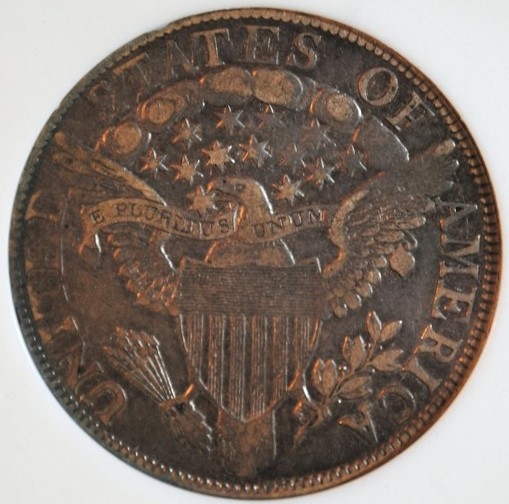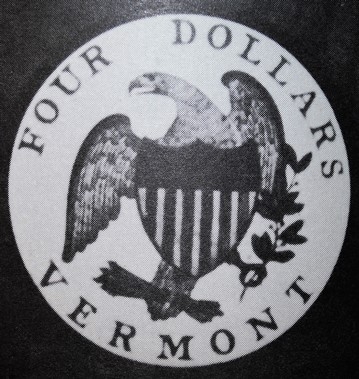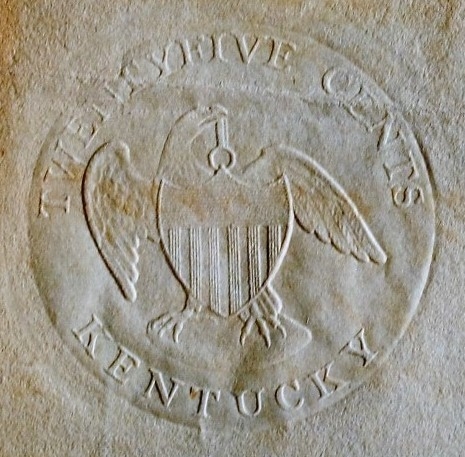Heraldic Eagle Arrow direction, and the Quasi/Barbary Wars
 Nysoto
Posts: 3,826 ✭✭✭✭✭
Nysoto
Posts: 3,826 ✭✭✭✭✭
The Heraldic Eagle reverse used on all silver and gold denominations was a modification of the Great Seal of the United States. In the final description of the Great Seal design "The Olive Branch and Arrows denote the power of Peace & War exclusively vested in Congress." The Heraldic Eagle reverse has the arrows pointed in the same direction as the eagle's head, indicating war.
Numismatic authors have either described the arrow direction in the Heraldic Eagle reverse as a mistake by the engraver, or as possible "sabre rattling" without going into detail. A "mistake" of that magnitude would not have gone on for twelve years, in all denominations, from the engraver, through the Mint Director, Secretary of State, and the President. What is not described by authors is the extent of the Quasi-War and First Barbary War, which dominated United States military forces from 1796 through 1805. These wars were undeclared, but military action was authorized by Congress, along with several Congressional Acts for raising money through federal stamps in every state, on virtually all professional and legal documents.
French ships began seizing American vessels in 1795, and by June of 1797 Secretary of State Thomas Pickering reported 316 American ships seized by France. Upon inauguration, President John Adams began building American Naval forces. Adams denounced the French hostility, and described the American Eagle and Arrows as "emblems of defense," infuriating the American public of the French aggression. The First Barbary War had origins back to 1785, when pirates from North Africa's Barbary coast captured American ships, held sailors as slaves, and demanded tribute for their release. Dey Muhommad of Algiers declared war on the United States in 1785, and US Congress authorized the building of six navy ships in 1794 to fight the aggression. The Convention of 1800 ended the Quasi War, and the June, 1805 treaty ended the First Barbary War, after US Marines captured Derna "on the shores of Tripoli."
The Heraldic Eagle reverse wartime direction of the arrows was also seen in other designs. Chief Engraver Robert Scot engraved 240 dies in 1798, fifteen for every state, for the First Federal Issue of revenue stamps, which had four designs with the arrows in the wartime direction. Assistant Coiner Adam Eckfeldt got the contract to fabricate eighteen screw presses for this effort, at $5089.50 (mostly sub-contracting the labor). All for this was to raise substantial funds for the Quasi and Barbary Wars. Connecticut engraver Amos Doolittle also engraved an illustration in support of the Quasi and Barbary Wars with arrows in the direction of the eagle's head. Robert Scot engraved the Navy Department Seal in 1798 to support the action, a design still in use today.
The Heraldic Eagle reverse wartime direction of the arrows on coins and federal stamps by Chief Engraver Robert Scot was a clear and deliberate decision in support of Congressional action to fight the Quasi and First Barbary Wars.
Comments and opinions are welcome, along with posts of Heraldic Eagles!



Comments
Great topic @Nysoto !
I just came across the Heraldic Eagle facing arrows during the time of war while watching a West Wing rerun again. They were wondering how the carpet in the Oval Office is changed during times of war so the eagle is facing towards the arrows. At the time I looked up several images. In addition to the head, the ribbon is different because it is grasped in the beak. Because I couldn't find any coins with the head facing right like the President's Seal, I thought it would be neat if @dcarr made some war time overstrikes.
BTW, if anyone is interested in reading more on the Barbary Wars, I'm reading the following book now and it's excellent IMHO:
Zoins, thanks for both posts, and I have read the book, a fairly quick read that covers the important points (except how they raised money through Federal Stamps), and is also very timely with implications to the world situation today.
Here is one struck the same year as the treaty that ended the First Barbary War-
In honor of the memory of Cpl. Michael E. Thompson
In years past I thought I'd read that the arrows in the eagle's right talon were an indication of war while arrows in the left talon indicated peace.
Was that someone's misinterpretation of the actual meaning of the arrows versus talon location?
LanLord,
All of the design committees and development of the US Great Seal are in the Continental Congress records, which I have gone through in National Archives microfilm and their internal web archives. A fairly comprehensive account of these records are in the book The Eagle and The Shield, and I have a chapter on the Great Seal in my book on Robert Scot.
The three different committees on the Great Seal design came up with many rejected proposals, and they discussed the significance of the dexter and sinister sides of the design. It all boils down to the description of the final accepted design, of which I quoted in the original post of what I though was most relevant. In the Eagle and the Shield the government historian authors stated regarding Charles Thomson, responsible for the final design, "he put the olive branch for peace in his eagle's right talon and the arrows for war in the left talon, and his eagle faced right, as indeed a proper heraldic bird should."
For the Heraldic Eagle reverse coin design, Mint Director Elias Boudinot was also on the third design committee of the Great Seal, and Robert Scot engraved the original Great Seal die. Given their background, it is extremely unlikely they would have made a design mistake over the period of 12 years. They knew exactly what they were doing, in regards to the Heraldic Eagle design. Keep in mind the Heraldic Eagle reverse was a modification of the Great Seal, and not an exact duplication. By law, the reverse on gold and silver coins "there shall be the figure or representation of an eagle, with this inscription, "UNITED STATES OF AMERICA."
Numismatic authors who called the Heraldic Eagle reverse arrow placement and direction a mistake did not know the extent of the Quasi and Barbary wars, and all of the Congressional action that authorized military force, re-built the US Navy, and raised a significant amount of revenue. They never mentioned the Federal revenue stamps that Scot engraved in 1798 and 1800 to finance the wars, which also had the arrow placement in same positions as the Heraldic Eagle reverse.
Afford - the value of the embossed revenue stamped paper is based on rarity, and how prominent the signer was. They can run from $5 to over $1000.
Eric Jackson Revenue stamps has auctions that include these, and he is good to deal with. He occasionally has lower priced embossed revenue stamped paper on eBay. His website also has auction history. There are a few 1814-1816 John Reich engraved stamps on eBay right now - although they don't say that Reich engraved them because they are not aware of it. ebay.com/itm/EMBOSSED-REVENUE-STAMPED-PAPER-Scott-RM275a-promissory-note-/391672988262?hash=item5b31878266:g:gWcAAOSw9GhYdAy4
August 13, 1813
Witness: Mint Director Robert Patterson
Contract: Adam Eckfeldt, Assistant Coiner
"I have agreed to have executed for the Commissioner of Revenue eighteen sets of dies from original dies and hubs of the denomination specified in paper, marked a, so as to make a strong and permanent impression, without breaking or impairing the texture of the paper, and so as to suit the presses made by me [screw presses] and now in the possession of the government of the US. On each of the dies there will be inserted the value of the stamp with an Eagle bearing a shield, the form or position of which will be so varied that no two sets will correspond. The whole work shall be finished in an artist-like manner...
Adam Eckfeldt"
Adam Eckfeldt "agreed to have excecuted...in an artist-like manner." The artist was John Reich. Robert Scot got the 1798 and 1800 contract, and Eckfeldt got the 1813 contract which he sub-contracted the engraving to Reich. Eckfeldt was a mechanic, not an artist, and the eagles engraved are exactly in the style of John Reich (feather, beak, head), and are stylistically different than Scot's 1798 and 1800 dies.
The Third Federal Issue of revenue stamps were used to finance the War of 1812. On the example I linked, Reich engraved the die that embossed the five cent revenue stamp on the promissory note.
I believe the earlier Scot embossed revenue stamped paper are worth more, but I have not paid more than $150 for an example. The ones on eBay are less expensive, usually poorly written, stained, and with creases through the stamp.
Just finished the book "Thomas Jefferson and the Tripoli Pirates". The final chapters of the book describe some very heroic men and acts in great detail. Definitely role models in times of crisis. For me, Stephen Decatur was especially notable for his bravery and leadership. Here's a silver specimen of his War of 1812 medal awarded to commissioned officers on board his ship from Stack's a few years ago. Does anyone know where his gold medal resides?
He was also honored on the $20 dollar bill and a US stamp. The below are from Wikipedia:
Great thread... very interesting historical detail. Cheers, RickO
Brian Kilmeade wrote a book! THAT Brian Kilmeade!!
www.brunkauctions.com